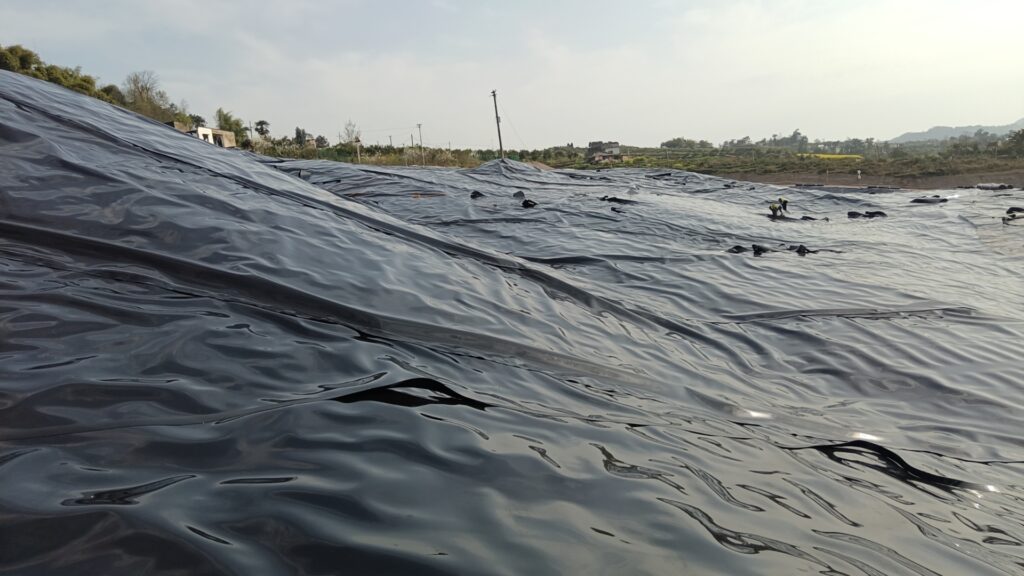The difference between pond tarp and geomembrane
Pond tarps and geomembranes serve similar purposes in pond construction and maintenance, but they have distinct differences in their materials, construction, and applications:
Material Composition:
Pond Tarps: Pond tarps are usually made of reinforced polyethylene or polypropylene materials. These materials are relatively flexible and often come in prefabricated sizes or can be custom-made for specific pond dimensions.
Geomembranes: Geomembranes are synthetic membranes typically made from materials like high-density polyethylene (HDPE), low-density polyethylene (LDPE), polyvinyl chloride (PVC), or ethylene propylene diene monomer (EPDM). Geomembranes tend to be thicker and more robust compared to pond tarps.
Strength and Durability:
Pond Tarps: Pond tarps are generally less durable and have lower puncture resistance compared to geomembranes. They are suitable for smaller ponds or temporary applications where durability requirements are not as high.
Geomembranes: Geomembranes are engineered to withstand harsh environmental conditions, including exposure to UV radiation, temperature fluctuations, and chemical exposure. They are designed for long-term use and are commonly used in larger ponds or for applications where high durability is essential, such as industrial waste containment or agricultural irrigation reservoirs.
Installation:
Pond Tarps: Pond tarps are relatively easy to install and often require minimal site preparation. They can be laid out over the pond area and anchored in place using weights, stakes, or other securing methods.
Geomembranes: Geomembranes typically require more extensive installation procedures, including proper subgrade preparation, anchoring, and sealing techniques. They may also require specialized equipment and trained personnel for installation to ensure proper performance and longevity.
Cost:
Pond Tarps: Pond tarps are generally more affordable compared to geomembranes. They offer a cost-effective solution for small-scale pond projects or temporary applications.
Geomembranes: Geomembranes tend to be more expensive due to their higher-quality materials and durability. However, they provide long-term cost savings by reducing the need for frequent repairs or replacements.
Applications:
Pond Tarps: Pond tarps are commonly used for small decorative ponds, backyard water features, or temporary water containment needs.
Geomembranes: Geomembranes are suitable for a wide range of applications, including agricultural ponds, aquaculture facilities, mining operations, landfill liners, and industrial wastewater treatment ponds.
In summary, while both pond tarps and geomembranes can be used for pond construction and containment purposes, geomembranes offer superior durability and performance, making them suitable for larger and more demanding applications where longevity and reliability are critical. Pond tarps, on the other hand, provide a more cost-effective solution for smaller-scale or temporary pond projects.
Can the pond tarp be made of hdpe?
Yes, pond tarps can be made of HDPE (high-density polyethylene) material. HDPE is a common choice for pond tarps due to its durability, resistance to punctures, and flexibility. HDPE pond tarps are often used for smaller ponds, decorative water features, or temporary water containment applications where a cost-effective solution is desired. While HDPE pond tarps may not offer the same level of durability and performance as geomembranes made of HDPE, they still provide adequate protection for many pond projects.

What kind of material is hdpe?
HDPE stands for High-Density Polyethylene. It is a type of thermoplastic polymer made from ethylene monomer units. HDPE is produced through a process called polymerization, which involves linking together many ethylene molecules to form long chains. This results in a material with a high molecular weight and a dense structure, hence the term “high-density” polyethylene.
HDPE is known for its excellent strength-to-density ratio, chemical resistance, and versatility. It is widely used in various applications including packaging, pipes, bottles, toys, containers, geomembranes, and pond liners, among others. HDPE is valued for its toughness, flexibility, resistance to impact, moisture, and chemicals, making it suitable for a wide range of industrial, commercial, and consumer products. Additionally, HDPE is recyclable and considered to be one of the most environmentally friendly plastics.

